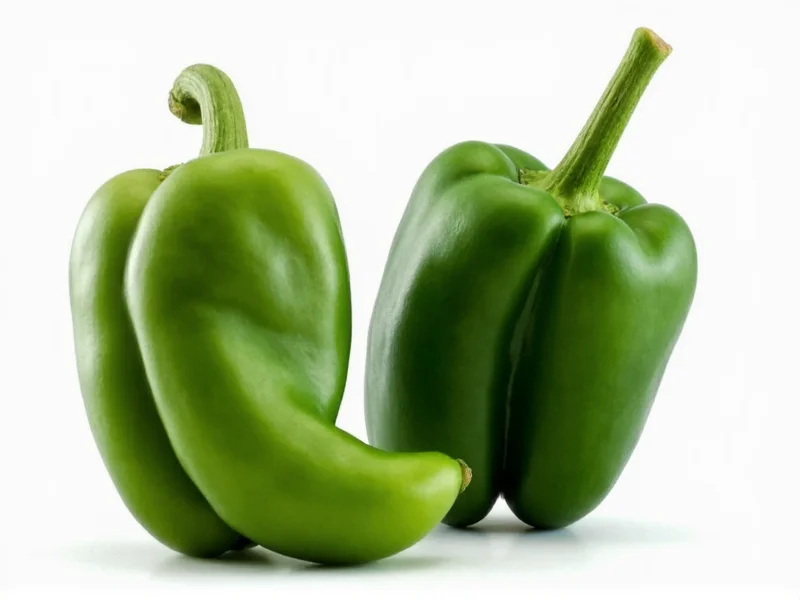The key difference between poblano and pasilla peppers is that poblano peppers are fresh, large, heart-shaped green peppers with mild heat (1,000-2,000 SHU), while pasilla peppers are actually dried chilaca peppers—long, narrow, dark brown/black in color with medium heat (1,000-2,500 SHU). Despite common confusion, they are not the same pepper at different stages; poblanos become anchos when dried, not pasillas.
Many home cooks confuse poblano and pasilla peppers because their names sound similar and they're both staples in Mexican cuisine. Understanding the distinction between these two peppers is essential for authentic flavor in your dishes. Let's explore their characteristics, culinary applications, and how to use them correctly.
Visual Identification: Telling Poblanos and Pasillas Apart
At first glance, these peppers might seem similar, but they have distinct visual characteristics. Fresh poblano peppers are large (3-6 inches long), heart-shaped, and dark green with thick walls. When mature, they turn deep red. Pasilla peppers, however, are always found in their dried form—they're long (6-8 inches), narrow, wrinkled, and dark brown to black in color.
One common misconception is that pasilla peppers are simply dried poblanos. This is incorrect. Poblanos become ancho peppers when dried. Pasillas come from a completely different fresh pepper called chilaca.
Flavor Profiles and Heat Levels Compared
Understanding the poblano vs pasilla pepper heat difference is crucial for recipe success:
| Pepper Type | Scoville Heat Units | Flavor Profile | Texture |
|---|---|---|---|
| Fresh Poblano | 1,000-2,000 SHU | Earthy, slightly sweet, grassy notes | Thick, meaty flesh |
| Pasilla (dried chilaca) | 1,000-2,500 SHU | Fruity, raisin-like, smoky, berry notes | Thin, brittle skin |
While their heat ranges overlap, poblanos generally feel milder in practice due to their higher water content. Pasillas deliver more concentrated heat and complex flavor because they're dried.
Culinary Applications: When to Use Each Pepper
Knowing when to use poblano vs pasilla pepper can make or break traditional Mexican dishes:
Fresh Poblano Pepper Uses
- Ideal for stuffing (chiles rellenos)
- Perfect for roasting and adding to salsas
- Great in casseroles and egg dishes
- Excellent when sliced for fajitas
- Works well in cream-based sauces
Pasilla Pepper Uses
- Essential for authentic mole sauces
- Perfect for adobo marinades
- Great in slow-cooked stews and braises
- Ideal for complex salsas (rehydrate first)
- Adds depth to vegetarian dishes
Substitution Guide: Poblano vs Pasilla Pepper Swaps
When you can't find the specific pepper called for in a recipe, understanding poblano and pasilla pepper substitution options is valuable:
Substituting for Fresh Poblanos
- Best fresh substitute: Anaheim peppers (similar mild heat)
- Good alternative: Cubanelle peppers (milder)
- Dried option: Ancho peppers (reconstituted) for cooked dishes
Substituting for Pasilla Peppers
- Best dried substitute: Mulato peppers (similar flavor profile)
- Good alternative: Guajillo peppers (brighter flavor)
- Fresh option: Fresh chilaca peppers (rare) or a mix of ancho and guajillo
Never substitute fresh poblanos for pasillas in traditional mole recipes—this poblano vs pasilla pepper mistake will significantly alter the dish's flavor profile. The dried pasilla's concentrated, fruity notes are irreplaceable in these complex sauces.
Growing Origins and Availability
Poblano peppers originated in Puebla, Mexico (hence the name), and are widely available fresh in North American grocery stores year-round. They're harvested green when mild, or red when slightly hotter and sweeter.
Pasilla peppers come from the chilaca variety, which is rarely sold fresh outside Mexico. The fresh chilaca is long, thin, and dark green, maturing to brown. When dried, it becomes the pasilla. In the United States, you'll almost exclusively find pasillas in their dried form, often labeled as "pasilla" or "chile negro. "
Proper Storage Techniques
Correct storage preserves the unique qualities of each pepper:
Storing Fresh Poblanos
- Refrigerate in a paper bag in the crisper drawer
- Lasts 1-2 weeks when stored properly
- Freeze roasted and peeled poblanos for longer storage
- Do not wash until ready to use
Storing Dried Pasillas
- Keep in an airtight container away from light and moisture
- Store in a cool, dark place (pantry is ideal)
- Properly stored, they maintain quality for 6-12 months
- Check periodically for moisture or mold
Cooking Tips for Maximum Flavor
To get the most from your poblano vs pasilla pepper selection:
- For poblanos: Roast over open flame to loosen skin, then peel—this enhances their natural sweetness
- For pasillas: Briefly toast in a dry skillet before rehydrating to unlock deeper flavors
- Always remove seeds and membranes from both peppers to control heat
- Rehydrate dried pasillas in hot water or broth for 15-20 minutes before use
- When substituting, adjust quantities based on heat differences
Common Misconceptions Clarified
Several myths persist about these peppers:
- Myth: Pasilla is just a dried poblano
Truth: Poblanos become anchos when dried; pasillas come from chilaca peppers - Myth: They can be used interchangeably in recipes
Truth: Their flavor profiles differ significantly—substitution changes dish character - Myth: Pasilla means "little raisin" because of its size
Truth: It refers to the pepper's dark, wrinkled appearance resembling a raisin











 浙公网安备
33010002000092号
浙公网安备
33010002000092号 浙B2-20120091-4
浙B2-20120091-4